Data Restore Faith in Medtronic's HVAD for Destination Therapy
April 6, 2017
Medtronic's HVAD left ventricular assist device, which it inherited last year through its $1.1 billion HeartWare acquisition, showed promising results in terms of death and disabling stroke at 12 months, but missed the primary endpoint that included all neurological events, in the ENDURANCE Supplemental trial.
Amanda Pedersen

Medtronic has submitted data from the ENDURANCE Supplemental trial to FDA to support a destination therapy indication for the HVAD left ventricular assist device.
Two years ago, HeartWare Inc., before it was acquired by Medtronic plc, presented results from the ENDURANCE destination therapy trial, designed to prove that its HVAD left ventricular assist device (LVAD) was suitable as a destination therapy, rather than just as a bridge to help patients survive while they wait for a heart transplant.
The data wasn't bad - in fact, the trial met its primary endpoint by showing the HVAD was non-inferior to Thoratec Corp.'s HeartMate II device in terms of stroke-free survival at two years. But HVAD still showed a high enough stroke rate in that first cohort of the ENDURANCE trial to make investigators uncomfortable.
But the company also noticed that patients treated at centers where better blood pressure management was used in conjunction with the HVAD implant, had significantly better outcomes (lower stroke rate) than patients who did not receive the same level blood pressure management, David Steinhaus, MD, vice president and general manager of Medtronic's heart failure business, told Qmed. So a supplemental trial was conducted to demonstrate that by controlling blood pressure in HVAD patients, the stroke rate could be brought back down to what would be considered a reasonable rate.
"And, in my view, that's exactly what it did do," Steinhaus said.
Medtronic reported results of the ENDURANCE Supplemental trial in a late-breaking session Wednesday at the International Society for Heart and Lung Transplantation (ISHLT) meeting in San Diego.
This time around, the trial did not meet its primary endpoint, which included all neurologic events at 12 months, including transient ischemic attacks. But the supplemental trial did show that 76.4% of patients receiving the HVAD system were alive on the originally implanted device and free of disabling stroke, compared to 66.9% of patients in the control arm. This pre-specified secondary endpoint analysis showed the HVAD was superior to the HeartMate II by an absolute difference of 9.2%, by the composite endpoint used in most LVAD trials.
This secondary endpoint, particularly the reduced rates of disabling stroke and the promising effects of optimal blood pressure management, was the key takeaway of the ENDURANCE Supplemental trial, Steinhaus said, and Medtronic is hopeful that it will be enough to gain FDA approval for offering the HVAD to U.S. patients as a destination therapy.
"We hope to be able to offer this therapy to the very sick population of patients in the U.S. who are ineligible for a heart transplant, and rely upon mechanical circulatory support as long-term distrination therapy," he said.
The supplemental trial revealed a rate of disabling stroke or death of 18.8% at 12 months among HVAD patients, compared to 21.6% of patients receiving the HeartMate II. However, the data also showed that 14.7% of HVAD patients experienced a neurologic event within that time period, while only 12.1% of HeartMate II patients (the control arm) had a neurologic event within 12 months of implantation.
The results were well-received at the ISHLT meeting, according to Steinhaus, as most of the clinicians were more focused on the rate of death and disabling stroke, than all neurologic event data.
"People were quite excited about it, this is the data they were waiting to see," he said.
Carmelo Milano, MD, co-principal investigator of the trial, and the surgical director of cardiac transplantation and LVAD programs at Durham, NC-based Duke University Medical Center, acknowledged that investigators were concerned about the higher rate of stroke seen in the ENDURANCE trial among HVAD patients, compared to the control group.
"In the ENDURANCE Supplemental trial, that gap closed and the stroke rates are comparable," he said, adding that there was no statistically significant difference between the HVAD and HeartMate II patients. "We believe the narrowing of those rates was most likely due to blood pressure management."
Additional analyses comparing results of the two trials showed a 24.7% reduction of overall stroke and transient ischemic attack incident, and a 50% reduction in hemorrhagic strokes, in HVAD patients.The ENDURANCE Supplemental trial enrolled 308 patients in the HVAD arm, and 157 patients in the control arm, for the same destination therapy indication.
Amanda Pedersen is Qmed's news editor. Contact her at [email protected].
[Image credit: Medtronic plc]
About the Author(s)
You May Also Like


